By Nathaniel Sharp
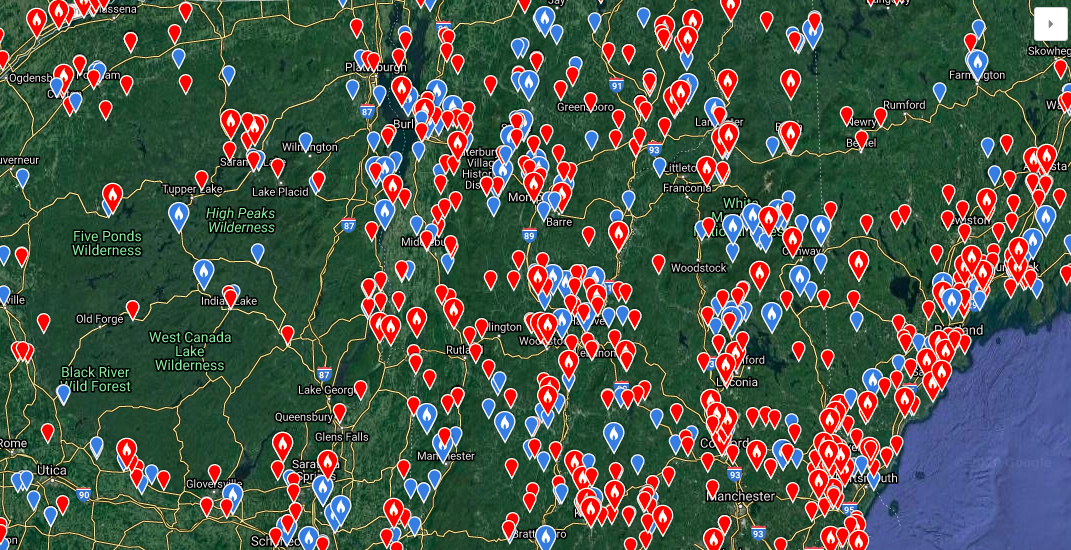
Vermont eBird data showing Evening Grosbeak reports from Vermont and adjacent states.
Way back in August, there were murmurings in the birding world of increased numbers of Purple Finches and Red-breasted Nuthatches in northern North America, with some trickling farther south than their usual late-summer range. In September, Tyler Hoar released the first Winter Finch Forecast since the retirement of Ron Pittaway from his long-held position as the compiler and distributor of finch food crop reports from the boreal forest. The general consensus of the forecast was that it would be an above average flight year for many of the “winter finches” and other irruptive species of the north, including Purple Finches, Red and White-winged Crossbills, Pine Siskins, Evening Grosbeaks, and Common and Hoary Redpolls. This news thrilled birders across North America, who began to stock up on bird seed and study up on the flight calls of these enigmatic northern visitors.
In early December here in Vermont, that original forecast has held true, with some welcome appearances by birds that were not expected to have significant flights into the northeast, such as Pine Grosbeaks, Bohemian Waxwings, and even Boreal Chickadees! From crabapples, to conifer cones, to black oil sunflower seed in backyard feeders, the food crop available to these irruptive species has been bountiful in Vermont, and the birds have taken notice. Though winter is only just beginning, numbers for just about every single irruptive winter species are far higher across the state than in previous years, and below you can find a breakdown of the status of each species in Vermont so far in this unprecedented winter of 2020.
Purple Finch
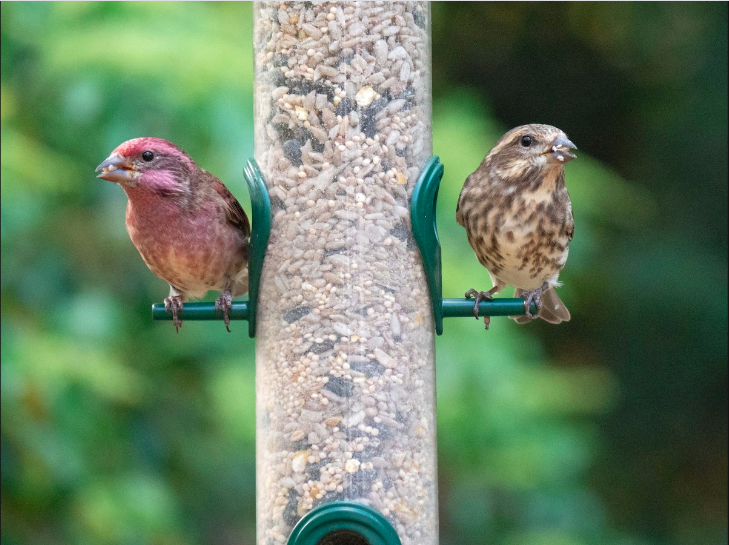
Male and Female Purple Finches at a bird feeder. © Susan Elliott
While Purple Finches are generally quite common year-round in Vermont, this year they have been exceptionally abundant, possibly due to recent outbreaks of spruce budworm in the boreal region creating an abundance of food and, therefore, an abundance of new Purple Finches. Most Purple Finch movement has taken place farther south of Vermont, with this species becoming a common appearance in states where it is generally uncommon in winter. Reports to Vermont eBird have slowed slightly in the last month or two, but this species is still quite abundant throughout Vermont this winter, and can be seen frequenting backyard bird feeders among Black-capped Chickadees, Red-breasted Nuthatches, and American Goldfinches.
Pine Siskin
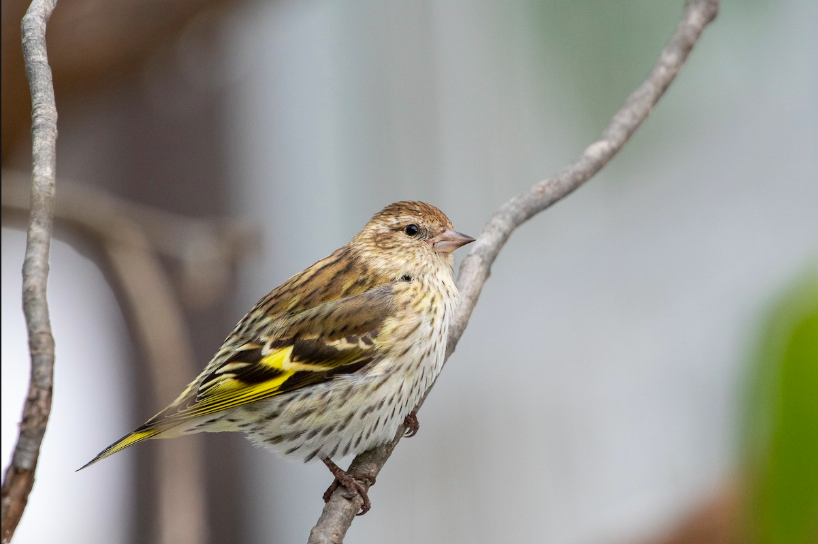
Pine Siskin © Richard Littauer
Early Pine Siskin reports were the first to show that something big was going on with winter finch movement in 2020. As early as October, reports were pouring in of huge flocks of siskins devouring thistle seed at backyard feeders. Flocks of several dozen Pine Siskins were reported from Vermont and, surprisingly, many states farther south, indicating that these feisty finches were definitely on the move. Listen for their buzzy vocalizations and distinct, clear flight calls while out and about this winter, as this species has been more abundant than usual since late summer of this year, and will likely continue to be throughout the winter. For a fun challenge, see if you can spot one of the distinctive, colorful “green morph” Pine Siskins among the flocks in your backyard or local patch.
Red and White-winged Crossbill
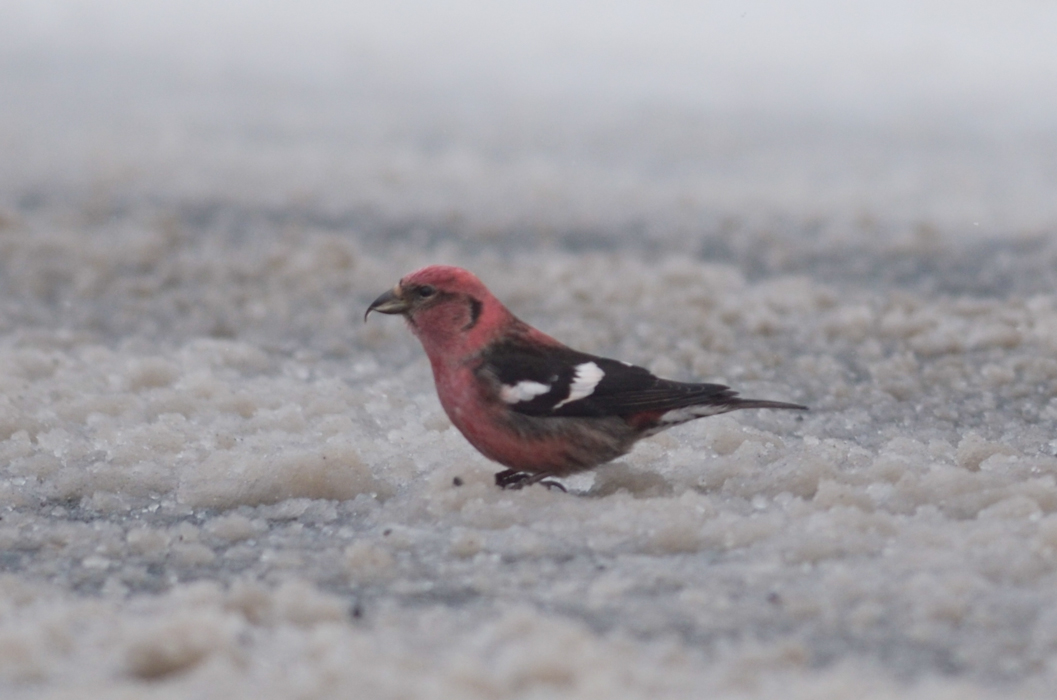
White-winged Crossbill “gritting” on a slushy road. © Nathaniel Sharp
Two highly nomadic species that are dependent on local cone crops for their primary food source are both visiting Vermont in significantly higher numbers than usual, and have been seen far and wide in the state. White-winged Crossbills were predicted to have a modest flight south, and they have exceeded expectations, leaving their usual haunts in northern Vermont to turn up in conifer stands throughout the state. Most Vermont eBird reports are currently coming in from Essex County, where they are usually most common, and the Champlain and Connecticut River Valleys, where they are generally less common in winter, with some even turning up as far south as Guilford.
Red Crossbills, on the other hand, have been widespread and somewhat abundant across the state so far this fall and winter. Look for these parrot-like finches feeding on conifer cones or gritting on roadsides, and if you find some, be sure to make a recording with your phone or other handheld recording device. There are several groupings of Red Crossbills known as “Types” that specialize on different types of cones and can be identified by flight call. Currently, only Type 10 Red Crossbills have been recorded so far this winter in Vermont, but Types 1, 2, 3, and 4 are also known to irrupt into the state. For more on Red Crossbill types, check out our Field Guide to December or the Finch Research Network Red Crossbill page.
Evening Grosbeak
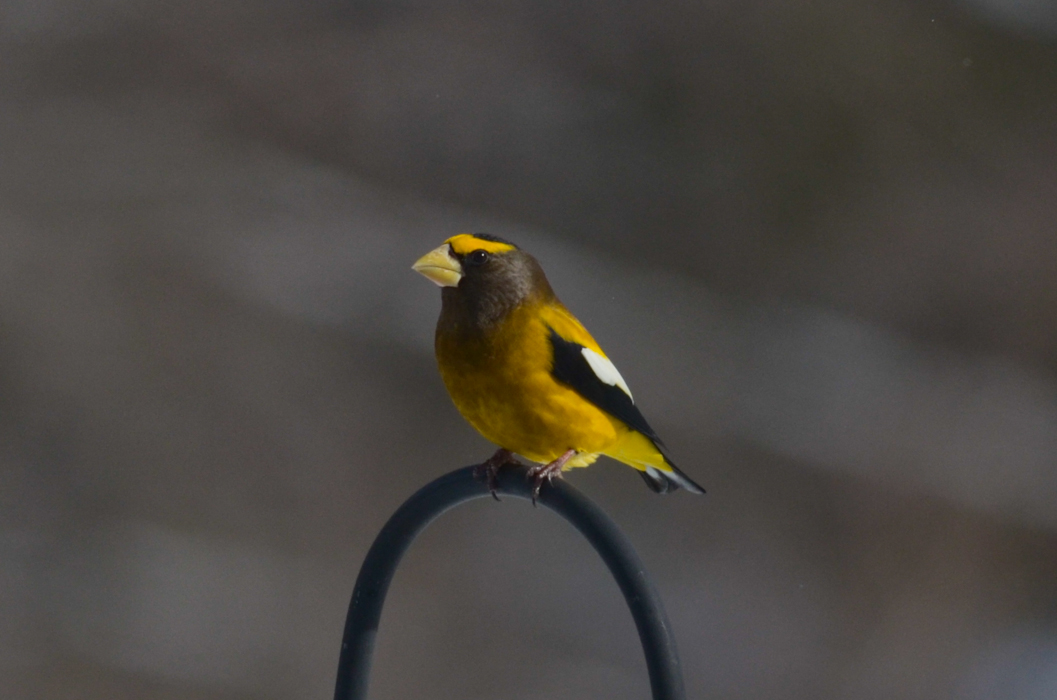
Adult male Evening Grosbeak. © Nathaniel Sharp
This bold yellow finch that was once common at feeders in huge numbers throughout Vermont, has experienced significant declines in recent decades for reasons largely unknown. Some good news though is that the recent spruce budworm outbreak in the boreal forest may be helping this species out as well and contributing to its robust irruptive flight this winter. This stunning species may be the most familiar winter finch to many, as its large size and bright colors are almost impossible to miss! Besides a smaller irruptive flight in 2018, this is the first time in recent years where Evening Grosbeaks have been reported from every corner of Vermont, with small flocks reported from every VT county, and many reports of Evening Grosbeaks visiting bird feeding stations stocking black oil sunflower. There have even been Evening Grosbeaks seen this winter as far south as Florida! Be sure to keep an ear out for their House Sparrow-like, ringing kleerr calls as they fly overhead.
Common and Hoary Redpoll
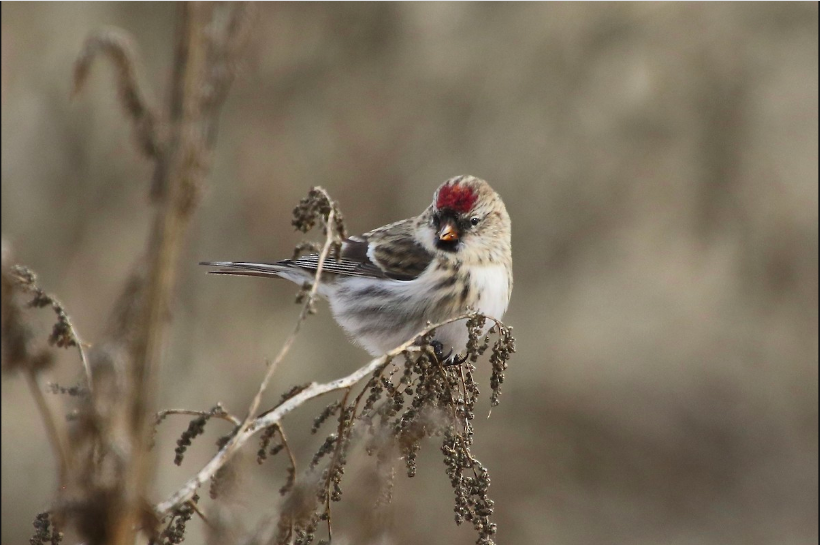
Common Redpoll © E R
Every year, a handful of Common Redpoll flocks numbering in the dozens can be expected in open areas throughout Vermont, in exceptional years, those flocks may contain a Hoary Redpoll or two. This year, those flocks are more numerous and widespread, with smaller groups heard as flyovers in locations across the state. Notoriously tricky to ID, and of questionable validity as a species, the Hoary Redpoll appears to be due for a good year in Vermont, with two turning up in Windsor county, and other reports from the Champlain Valley. So far this winter, flocks of 100+ Common Redpolls have been reported, and many birders have seen redpolls joining American Goldfinches and Pine Siskins at their bird feeders. Look for these flocking finches in farm fields with dead seed-bearing grasses and weeds, as well as in birches, where they can often be found feeding on catkins.
Pine Grosbeak
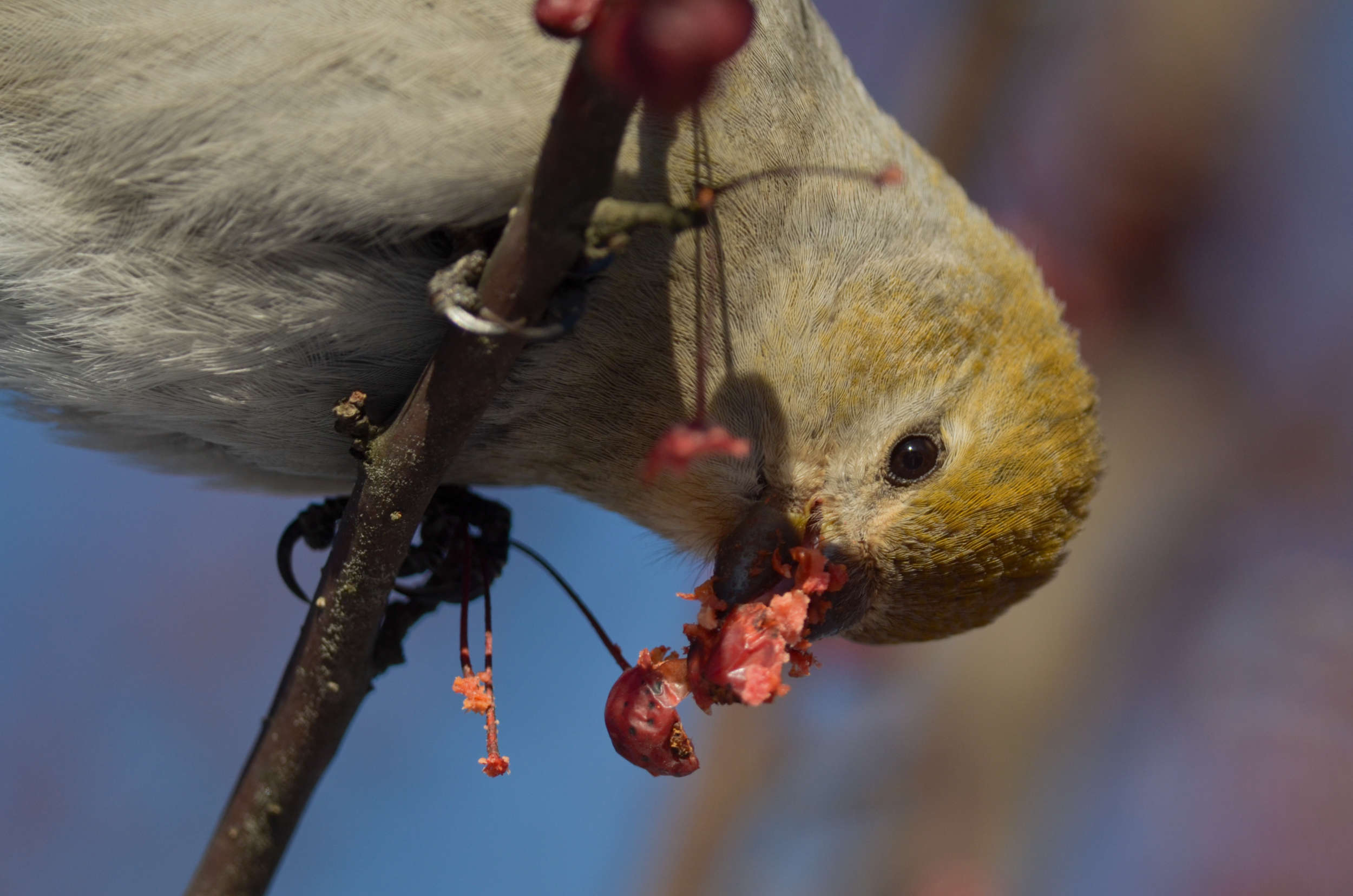
Close-up of a female Pine Grosbeak feeding on crabapples. © Nathaniel Sharp
Originally not expected to experience a significant push southward, Pine Grosbeaks seem not to have listened to the forecast and stormed into Vermont anyways, laying waste to all crabapples and hawthorns in their path. Within the last few weeks, reports have poured in to Vermont eBird from across the state, and it seems that anywhere that ornamental fruiting trees can be found, Pine Grosbeaks can be as well. Interestingly, most reports note a lack of adult males, with flocks instead comprised of females and immature males. Most years in the past decade saw no Pine Grosbeak reports in Vermont between October and December, and those that did saw concentrations in the northern half of the state. This early invasion of Pine Grosbeaks throughout the state is a great opportunity to spend some quality time with these “parrots of the north”. To learn more about Pine Grosbeaks, check out this episode of Outdoor Radio from last winter.
Bohemian Waxwing
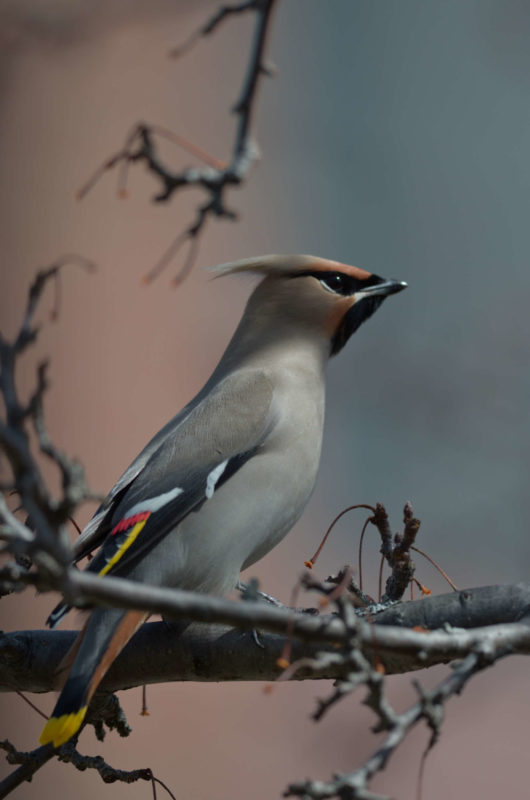
Bohemian Waxwing © Nathaniel Sharp
In stark contrast to the early winter of 2019, which saw a grand total of 0 Bohemian Waxwing reports in Vermont, this year has seen a smattering of reports from across the northern half of the state, often of small flocks of Bohemian Waxwings feeding on fruiting ornamental trees among flocks of Pine Grosbeaks. Similar to Pine Grosbeaks, Bohemian Waxwings were not expected to experience a significant southward flight this year, so the above-average numbers being seen so far in northern VT in recent months are a welcome surprise. Compared to the massive irruptive flight of the winter of 2018 though, this year’s Bohemian Waxwing flight has fallen well short, though they could continue to move through the state as winter progresses along.
Boreal Chickadee
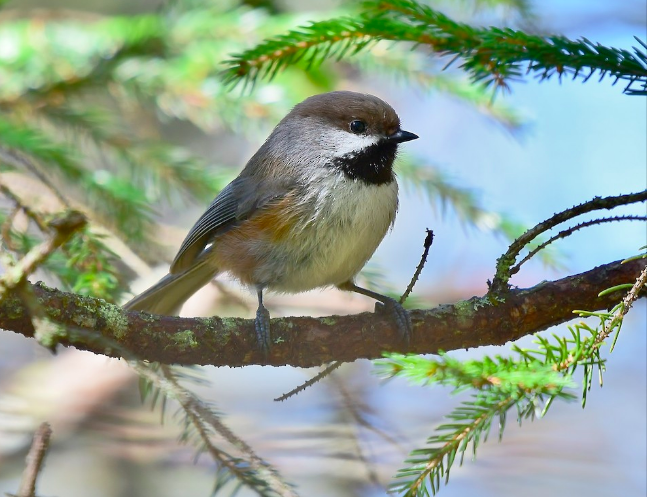
Boreal Chickadee © Thomas Berriman
Undoubtedly the biggest surprise of this winter irruption has been the movements of Boreal Chickadees out of their Vermont stronghold of the Northeast Kingdom. This hardy, brown and gray, boreal relative of the Black-capped Chickadee is rarely seen in Vermont anywhere besides Essex County, making reports from Mount Ascutney and Hunger Mountain especially noteworthy. Three individuals seen and heard well and reported by experienced birders (including VCE’s own Chris Rimmer) represent the southernmost early-winter record of Boreal Chickadee in the state. Besides a few reports in southern Vermont in the early 2000s, there have been almost no reports of Boreal Chickadees outside of the Northeast Kingdom since the 1980s, making this year an exceptional deviation from the norm. Will more Boreal Chickadees turn up on mountain peaks elsewhere in the state? If you’re planning on hiking any of Vermont’s peaks this winter, be sure to keep an ear out for the harsh, burry, chickadee-dee-dee call of this boreal species on the move.
As days grow shorter and the bright colors of warblers and tanagers become a distant memory, winter finches and other irruptive species provide a burst of color and energy across the Vermont winter landscape. During this historic year for winter finches, be sure to get outside and enjoy them whenever possible, and don’t forget to upload your sightings to Vermont eBird!

I live in Grantham, NH and have had several pine grosbeaks in my yard feeding on the ground and in the Korean Ash tree.
How exciting! Have you seen any of the bright-pink males in the flock? So far it seems the majority of the Pine Grosbeaks that are visiting the northeast are the russet- or brown-and-gray females and immature males.
Nice summary Nathaniel. Yes, it has been a great fall for finding these special birds this far “south”. We’re still hoping the Bohemian Waxwings make it into Windsor County before the Pine Grosbeaks eat up all the crabapples. What a fun “problem” to have!
So far the only Bohemian I’ve seen this winter was a lone individual associating with a flock of Pine Grosbeaks in Fairlee. It looks like there are good numbers hanging around Montreal and Ottawa, hopefully they’ll head a little farther south in the coming weeks!
Nathaniel, Thank you for the very informative report on the finch populations in our region this Fall and early Winter. Our feeders are currently frequented by the usual suspects seen during this time of year. We will inform you if any of the above visit our feeders going forward. Regards and thank you Nathaniel and VCE.
Richard, thank you for keeping watch! If you do encounter any of these northern visitors, feel free to upload your sightings to Vermont eBird or the Vermont Atlas of Life on iNaturalist.
Hi. I live in Derby, VT and noticed this spring there are no finches coming to my house. Has anyone else mentioned the lack of Goldfinch and purple finches? I usually have 10-20 at a time at my feeder in the spring. I also have a large cherry tree and this is the first time in many years I have been able to pick the ripe fruit. Usually, the minute the cherries are ripe the birds est them. Where have all the finches gone?
Christina Cotnoir
Hello Christina,
While there are certainly other factors that could be at play here, my best guess for why you haven’t been seeing many finches at your feeder recently is because they are likely using a different food source this time of year! During the spring, fall, and winter especially, many birds (finches included) frequently visit bird feeders to chow down on seed. During the midsummer though, most finches are raising young and feeding them a diet consisting primarily of insects and other arthropods. This might explain the lack of birds at your feeder around this time of year.
-Nathaniel